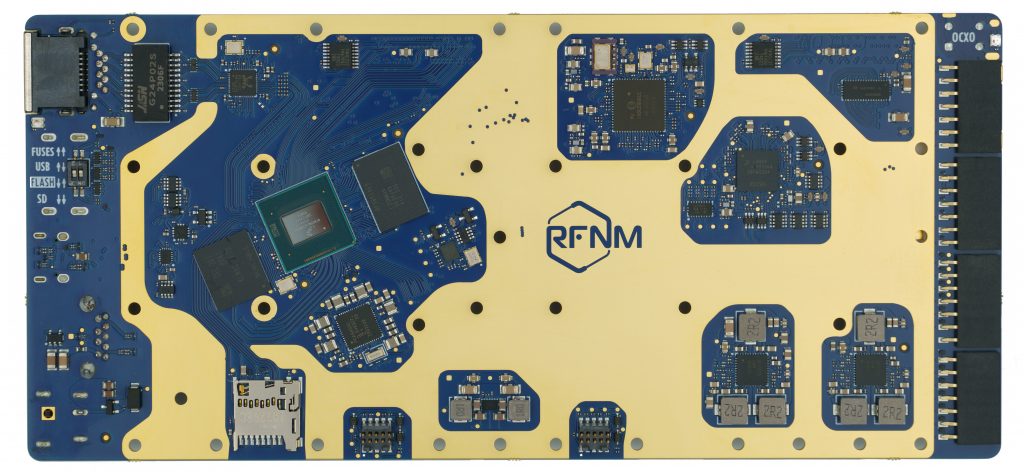Or, how the motherboard apparently works?!
After two weeks of intensive physic sessions and a trip to the CNC shop to drill a tiny hole and untie a power plane from ground (a small extra left behind by the PCB manufacturer) … everything just sort of works?
Maybe getting a complex design right the first time wasn’t a myth, after all.
So, what does work?
- LPDDR4, the destroyer of designs, running happily at 2 GHz (4000 MT/s).
- The i.MX 8M Plus, our main embedded processor, also happily cracking away at numbers. PMIC, eMMC 5.1, SD card, Power Delivery, USB-C/A, HDMI, etc.
- Si5510, the clock generator IC. The outputs coming out of the Skyworks, ex. Silicon Labs chip are looking beautiful. However, the equipment to actually verify phase noise of said clocks is very, very expensive (think $100k), we’re trying to find a way to get access to it.
- LA9310, the star of the show, that negotiates a PCIe 3.0 1x link just fine, but originally didn’t want to map its 256 MB BAR1 address to the iMX (clever kernel hacking from NXP solves this).
What works, but only after rework?
- Ethernet. Apparently the pinout weirdness extends to the connector, not just to the RJ-45 crimping process. The pinout maps linearly, with the exception of pins 4, 5 and pin 6, which are swapped (1, 2, 3, 5, 6, 4, 7, 8).
- Every level translator on the board (and there are seven!). This one was terrible. A combination of a “dead bug” footprint mistake and ringing from the ICs at high output capacitance is making us switch to the TXB/TXS series from TI. We had to order our own tiny interposer PCBs to fix our mistake, but it’s yet another tool under out belt now.
- The LDOs had the output FB capacitor connected between FB and GND, rather than FB and VOUT. This played with the poles of the device.
What doesn’t work and cannot be fixed by rework?
- Nothing! Fingers crossed this list stays empty.
The PCB manufacturing experience
Our PCB manufacturing partner, Multi-CB (big EU player), delayed the project by about three weeks and finally delivered boards with an internal power plane shorted to ground. Head over to the eevblog forum for the full rant.
So, how do you fix a PCB with a power plane shorted to ground? Easy, you spend the morning patiently scraping away layer by layer until you locate the short under a microscope. You then hand the batch over to a local machine shop to drill a hole exactly where the copper shouldn’t be, but making sure you don’t drill too deep, or you might destroy places the copper actually needs to be. Some luck is involved, so if the stars align, you can save the boards that way. Child’s play, really.

What’s next?
We have everything in stock for the first proto run of the Granita daughterboard, while the Lime LMS7002 PCBs are missing and should be coming next week, with a slot booked with our assembly house for the week starting the 17th of the month. If everything goes smoothly and our design is solid we should have those boards online in no time!
Once the modular concept of the design is verified, and we can get a basic final verification that the hardware is solid, we will open up preorders, which is expected to happen in August. We are spending insane amounts of money stocking up on components, and we should have everything required for the first batch of motherboards around September, which is just around the corner.
Motherboard pricing
The motherboard you will be able to preorder in August with expected ~October delivery will be $299 / €329. We are going full-out on the options, which is why the price is slightly higher than the expected $275. Mostly, we are adding:
- CNC machined aluminum enclosure covering the exposed side of the motherboard, providing a thermal management solution and protection against accidents.
- 4 GB LPDDR4, up from the initial 2 GB.
- 64 GB eMMC storage, up from 16 GB.
- 280 ppb TCXO (with the LTE timebase sync software, this is all we think we need to achieve ~zero frequency error).
- A MMCX to SMA adapter.
- The SN220E secure element. This is an eSIM module that can be used to deploy real network infrastructure. Its inclusion is subject to availability and functionality that we can offer with it.
Daughterboard pricing and delivery dates will come later, as we will need some fresh cash from the preorders and some data on your interests to decide how to schedule production of those boards and pay the RFIC suppliers.
